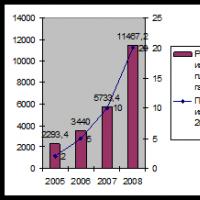Reduce the fraction and bring to a common denominator. Addition and subtraction of ordinary fractions. Bringing fractions to the same denominator. The concept of NOC. How to bring fractions to a common denominator? Rule, examples, solutions
Fractions have different or the same denominators. Same denominator or otherwise called common denominator at the fraction An example of a common denominator:
\(\frac(17)(5), \frac(1)(5)\)
An example of different denominators for fractions:
\(\frac(8)(3), \frac(2)(13)\)
How to find a common denominator of a fraction?
The first fraction has a denominator of 3, the second is 13. You need to find a number that is divisible by both 3 and 13. This number is 39.
The first fraction must be multiplied by additional multiplier 13. So that the fraction does not change, we must multiply both the numerator by 13 and the denominator.
\(\frac(8)(3) = \frac(8 \times \color(red) (13))(3 \times \color(red) (13)) = \frac(104)(39)\)
We multiply the second fraction by an additional factor of 3.
\(\frac(2)(13) = \frac(2 \times \color(red) (3))(13 \times \color(red) (3)) = \frac(6)(39)\)
We have reduced the common denominator of the fraction:
\(\frac(8)(3) = \frac(104)(39), \frac(2)(13) = \frac(6)(39)\)
Lowest common denominator.
Consider another example:
Let's bring the fractions \(\frac(5)(8)\) and \(\frac(7)(12)\) to a common denominator.
The common denominator for the numbers 8 and 12 can be the numbers 24, 48, 96, 120, ..., it is customary to choose lowest common denominator in our case, this number is 24.
Lowest common denominator is the smallest number that divides the denominator of the first and second fractions.
How to find the lowest common denominator?
By enumeration of numbers, by which the denominator of the first and second fractions is divided and choose the smallest of them.
We need to multiply the fraction with a denominator of 8 by 3, and multiply the fraction with a denominator of 12 by 2.
\(\begin(align)&\frac(5)(8) = \frac(5 \times \color(red) (3))(8 \times \color(red) (3)) = \frac(15 )(24)\\\\&\frac(7)(12) = \frac(7 \times \color(red) (2))(12 \times \color(red) (2)) = \frac( 14)(24)\\\\ \end(align)\)
If you can’t immediately bring the fractions to the lowest common denominator, there’s nothing to worry about, in the future, when solving the example, you may have to get the answer
A common denominator can be found for any two fractions; it can be the product of the denominators of these fractions.
For example:
Reduce the fractions \(\frac(1)(4)\) and \(\frac(9)(16)\) to the lowest common denominator.
The easiest way to find the common denominator is to multiply the denominators 4⋅16=64. The number 64 is not the lowest common denominator. The task is to find the smallest common denominator. So we are looking further. We need a number that is divisible by both 4 and 16, this is the number 16. Let's reduce the fraction to a common denominator, multiply the fraction with a denominator of 4 by 4, and the fraction with a denominator of 16 by one. We get:
\(\begin(align)&\frac(1)(4) = \frac(1 \times \color(red) (4))(4 \times \color(red) (4)) = \frac(4 )(16)\\\\&\frac(9)(16) = \frac(9 \times \color(red) (1))(16 \times \color(red) (1)) = \frac( 9)(16)\\\\ \end(align)\)
Bringing fractions to a common denominator
The fractions I have the same denominator. They say they have common denominator 25. Fractions and have different denominators, but they can be reduced to a common denominator using the basic property of fractions. To do this, we find a number that is divisible by 8 and 3, for example, 24. We bring the fractions to the denominator 24, for this we multiply the numerator and denominator of the fraction by additional multiplier 3. An additional factor is usually written on the left above the numerator:
Multiply the numerator and denominator of the fraction by an additional factor of 8:
We bring the fractions to a common denominator. Most often, fractions lead to the least common denominator, which is the least common multiple of the denominators of the given fractions. Since LCM (8, 12) = 24, then the fractions can be reduced to the denominator 24. Let's find additional factors of fractions: 24:8 = 3, 24:12 = 2. Then
You can bring several fractions to a common denominator.
Example. We bring fractions to a common denominator. Since 25 = 5 2 , 10 = 2 5, 6 = 2 3, then LCM (25, 10, 6) = 2 3 5 2 = 150.
Let's find additional factors of fractions and bring them to the denominator 150:
Fraction Comparison
On fig. 4.7 shows a segment AB of length 1. It is divided into 7 equal parts. Segment AC has length , and segment AD has length .
The length of segment AD is greater than the length of segment AC, i.e., the fraction is greater than the fraction
Of the two fractions with a common denominator, the one with the larger numerator is larger, i.e.
For example, or
To compare any two fractions, they are reduced to a common denominator, and then the rule for comparing fractions with a common denominator is applied.
Example. Compare fractions
Decision. LCM (8, 14) = 56. Then Since 21 > 20, then
If the first fraction is less than the second, and the second is less than the third, then the first is less than the third.
Proof. Let there be three fractions. Let's bring them to a common denominator. Let after that they will have the form Since the first fraction is less
second, then r< s. Так как вторая дробь меньше третьей, то s < t. Из полученных неравенств для натуральных чисел следует, что r < t, тогда первая дробь меньше третьей.
The fraction is called correct if its numerator is less than its denominator.
The fraction is called wrong if its numerator is greater than or equal to its denominator.
For example, fractions are proper and fractions are improper.
A proper fraction is less than 1 and an improper fraction is greater than or equal to 1.
- Adding and subtracting fractions with the same denominators
- Adding and subtracting fractions with different denominators
- The concept of the NOC
- Bringing fractions to the same denominator
- How to add a whole number and a fraction
1 Adding and subtracting fractions with the same denominators
To add fractions with the same denominators, you need to add their numerators, and leave the denominator the same, for example:

To subtract fractions with the same denominators, subtract the numerator of the second fraction from the numerator of the first fraction, and leave the denominator the same, for example:

To add mixed fractions, you must separately add their whole parts, and then add their fractional parts, and write the result as a mixed fraction,
Example 1:
Example 2:

If, when adding the fractional parts, an improper fraction is obtained, we select the integer part from it and add it to the integer part, for example:

2 Addition and subtraction of fractions with different denominators.
In order to add or subtract fractions with different denominators, you must first bring them to the same denominator, and then proceed as indicated at the beginning of this article. The common denominator of several fractions is the LCM (least common multiple). For the numerator of each of the fractions, additional factors are found by dividing the LCM by the denominator of this fraction. We'll look at an example later, after we figure out what an LCM is.
3 Least common multiple (LCM)
The least common multiple of two numbers (LCM) is the smallest natural number, which is divisible by both of these numbers without a remainder. Sometimes NOCs can be picked up orally, but more often, especially when working with big numbers, you have to find the LCM in writing, using the following algorithm:
In order to find the LCM of several numbers, you need:
- Decompose these numbers into prime factors
- Take the largest expansion, and write these numbers as a product
- Select in other expansions the numbers that do not occur in the largest expansion (or occur in it a smaller number of times), and add them to the product.
- Multiply all the numbers in the product, this will be the LCM.
For example, let's find the LCM of numbers 28 and 21:

4 Reducing fractions to the same denominator
Let's go back to adding fractions with different denominators.
When we reduce fractions to the same denominator, equal to the LCM of both denominators, we must multiply the numerators of these fractions by additional multipliers. You can find them by dividing the LCM by the denominator of the corresponding fraction, for example:

Thus, in order to bring fractions to one indicator, you must first find the LCM (that is, the smallest number that is divisible by both denominators) of the denominators of these fractions, then put additional factors on the numerators of the fractions. You can find them by dividing the common denominator (LCD) by the denominator of the corresponding fraction. Then you need to multiply the numerator of each fraction by an additional factor, and put the LCM as the denominator.
5 How to add a whole number and a fraction
In order to add a whole number and a fraction, you just need to add this number before the fraction, and you get a mixed fraction, for example:

If we add an integer and a mixed fraction, we add that number to the integer part of the fraction, like so:

Trainer 1
Addition and subtraction of fractions with the same denominators.
Time limit: 0
Navigation (job numbers only)
0 out of 20 tasks completed
Information
This quiz tests your ability to add fractions with the same denominator. In this case, two rules must be observed:
- If the result is an improper fraction, you need to convert it to mixed number.
- If the fraction can be reduced, be sure to reduce it, otherwise the wrong answer will be counted.
You have already taken the test before. You cannot run it again.
Test is loading...
You must login or register in order to start the test.
You must complete the following tests to start this one:
results
Correct answers: 0 out of 20
Your time:
Time is over
You scored 0 out of 0 points (0 )
- With an answer
- Checked out
Scheme of reduction to a common denominator
- It is necessary to determine what will be the least common multiple for the denominators of fractions. If you are dealing with a mixed or integer number, then you must first turn it into a fraction, and only then determine the least common multiple. To turn an integer into a fraction, you need to write the number itself in the numerator, and one in the denominator. For example, the number 5 as a fraction would look like this: 5/1. To turn a mixed number into a fraction, you need to multiply the whole number by the denominator and add the numerator to it. Example: 8 integers and 3/5 as a fraction = 8x5+3/5 = 43/5.
- After that, it is necessary to find an additional factor, which is determined by dividing the NOZ by the denominator of each fraction.
- The last step is to multiply the fraction by an additional factor.
It is important to remember that reduction to a common denominator is needed not only for addition or subtraction. To compare several fractions with different denominators, it is also necessary to first reduce each of them to a common denominator.
Bringing fractions to a common denominator
In order to understand how to reduce a fraction to a common denominator, it is necessary to understand some properties of fractions. So, an important property used to reduce to NOZ is the equality of fractions. In other words, if the numerator and denominator of a fraction are multiplied by a number, then the result is a fraction equal to the previous one. Let's take the following example as an example. In order to reduce the fractions 5/9 and 5/6 to the lowest common denominator, you need to do the following:
- First, find the least common multiple of the denominators. In this case, for the numbers 9 and 6, the NOC will be 18.
- We determine additional factors for each of the fractions. This is done in the following way. We divide the LCM by the denominator of each of the fractions, as a result we get 18: 9 \u003d 2, and 18: 6 \u003d 3. These numbers will be additional factors.
- We bring two fractions to NOZ. When multiplying a fraction by a number, you need to multiply both the numerator and the denominator. The fraction 5/9 can be multiplied by an additional factor of 2, resulting in a fraction equal to the given one - 10/18. We do the same with the second fraction: multiply 5/6 by 3, resulting in 15/18.
As you can see from the example above, both fractions have been reduced to the lowest common denominator. To finally understand how to find a common denominator, you need to master one more property of fractions. It lies in the fact that the numerator and denominator of a fraction can be reduced by the same number, which is called the common divisor. For example, the fraction 12/30 can be reduced to 2/5 if divided by common divisor- number 6.
The least common denominator (LCD) of these irreducible fractions is the least common multiple (LCM) of the denominators of these fractions. ( see the topic "Finding the least common multiple":
To bring fractions to the least common denominator, you must: 1) find the least common multiple of the denominators of these fractions, it will be the least common denominator. 2) find an additional factor for each of the fractions, why divide new denominator to the denominator of each fraction. 3) multiply the numerator and denominator of each fraction by its additional factor.
Examples. Reduce the following fractions to the lowest common denominator.

We find the least common multiple of the denominators: LCM(5; 4) = 20, since 20 is the smallest number that is divisible by both 5 and 4. We find for the 1st fraction an additional factor 4 (20 : 5=4). For the 2nd fraction, the additional multiplier is 5 (20 : 4=5). We multiply the numerator and denominator of the 1st fraction by 4, and the numerator and denominator of the 2nd fraction by 5. We reduced these fractions to the lowest common denominator ( 20 ).

The lowest common denominator of these fractions is 8, since 8 is divisible by 4 and itself. There will be no additional multiplier to the 1st fraction (or we can say that it is equal to one), to the 2nd fraction the additional multiplier is 2 (8 : 4=2). We multiply the numerator and denominator of the 2nd fraction by 2. We reduced these fractions to the lowest common denominator ( 8 ).

These fractions are not irreducible.
We reduce the 1st fraction by 4, and we reduce the 2nd fraction by 2. ( see examples on the reduction of ordinary fractions: Sitemap → 5.4.2. Examples of reduction of ordinary fractions). Find LCM(16 ; 20)=2 4 · 5=16· 5=80. The additional multiplier for the 1st fraction is 5 (80 : 16=5). The additional multiplier for the 2nd fraction is 4 (80 : 20=4). We multiply the numerator and denominator of the 1st fraction by 5, and the numerator and denominator of the 2nd fraction by 4. We reduced these fractions to the lowest common denominator ( 80 ).



